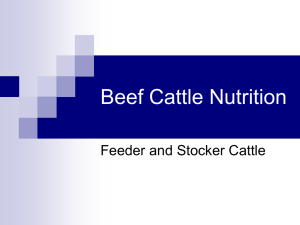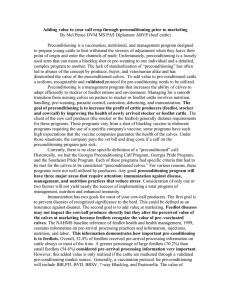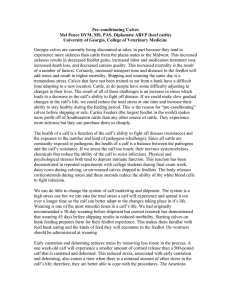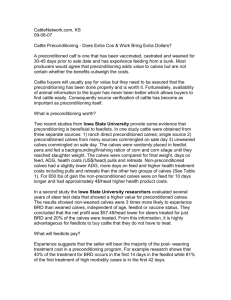Production Enhancement – Preconditioning Calves Prior to Marketing
advertisement
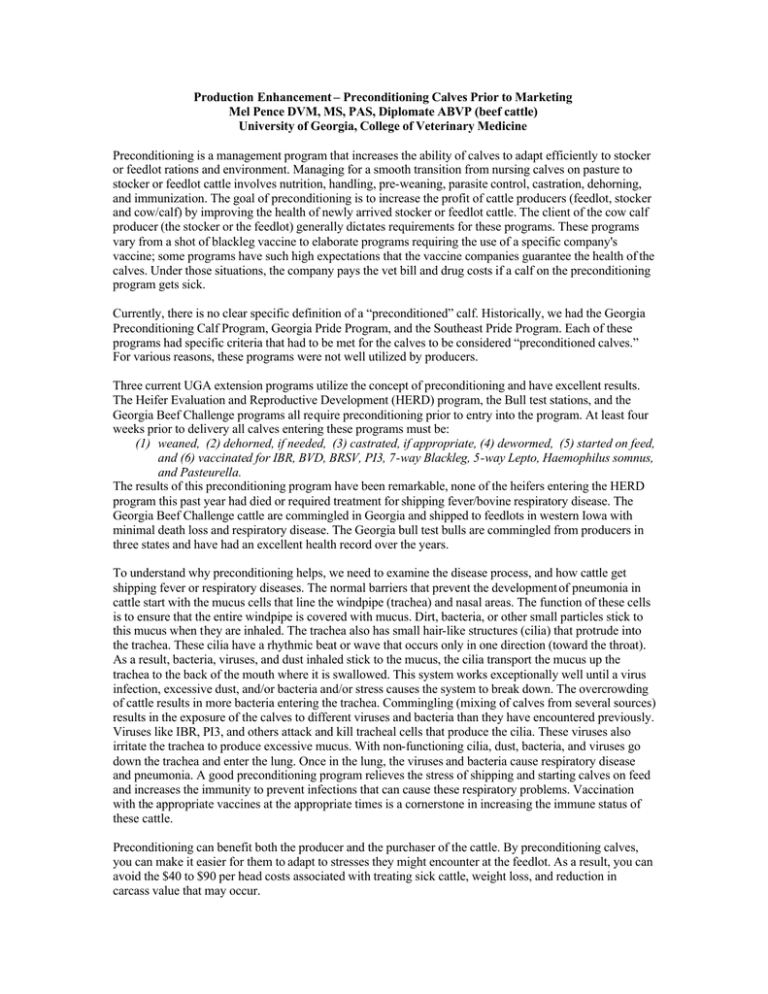
Production Enhancement – Preconditioning Calves Prior to Marketing Mel Pence DVM, MS, PAS, Diplomate ABVP (beef cattle) University of Georgia, College of Veterinary Medicine Preconditioning is a management program that increases the ability of calves to adapt efficiently to stocker or feedlot rations and environment. Managing for a smooth transition from nursing calves on pasture to stocker or feedlot cattle involves nutrition, handling, pre-weaning, parasite control, castration, dehorning, and immunization. The goal of preconditioning is to increase the profit of cattle producers (feedlot, stocker and cow/calf) by improving the health of newly arrived stocker or feedlot cattle. The client of the cow calf producer (the stocker or the feedlot) generally dictates requirements for these programs. These programs vary from a shot of blackleg vaccine to elaborate programs requiring the use of a specific company's vaccine; some programs have such high expectations that the vaccine companies guarantee the health of the calves. Under those situations, the company pays the vet bill and drug costs if a calf on the preconditioning program gets sick. Currently, there is no clear specific definition of a “preconditioned” calf. Historically, we had the Georgia Preconditioning Calf Program, Georgia Pride Program, and the Southeast Pride Program. Each of these programs had specific criteria that had to be met for the calves to be considered “preconditioned calves.” For various reasons, these programs were not well utilized by producers. Three current UGA extension programs utilize the concept of preconditioning and have excellent results. The Heifer Evaluation and Reproductive Development (HERD) program, the Bull test stations, and the Georgia Beef Challenge programs all require preconditioning prior to entry into the program. At least four weeks prior to delivery all calves entering these programs must be: (1) weaned, (2) dehorned, if needed, (3) castrated, if appropriate, (4) dewormed, (5) started on feed, and (6) vaccinated for IBR, BVD, BRSV, PI3, 7-way Blackleg, 5-way Lepto, Haemophilus somnus, and Pasteurella. The results of this preconditioning program have been remarkable, none of the heifers entering the HERD program this past year had died or required treatment for shipping fever/bovine respiratory disease. The Georgia Beef Challenge cattle are commingled in Georgia and shipped to feedlots in western Iowa with minimal death loss and respiratory disease. The Georgia bull test bulls are commingled from producers in three states and have had an excellent health record over the years. To understand why preconditioning helps, we need to examine the disease process, and how cattle get shipping fever or respiratory diseases. The normal barriers that prevent the development of pneumonia in cattle start with the mucus cells that line the windpipe (trachea) and nasal areas. The function of these cells is to ensure that the entire windpipe is covered with mucus. Dirt, bacteria, or other small particles stick to this mucus when they are inhaled. The trachea also has small hair-like structures (cilia) that protrude into the trachea. These cilia have a rhythmic beat or wave that occurs only in one direction (toward the throat). As a result, bacteria, viruses, and dust inhaled stick to the mucus, the cilia transport the mucus up the trachea to the back of the mouth where it is swallowed. This system works exceptionally well until a virus infection, excessive dust, and/or bacteria and/or stress causes the system to break down. The overcrowding of cattle results in more bacteria entering the trachea. Commingling (mixing of calves from several sources) results in the exposure of the calves to different viruses and bacteria than they have encountered previously. Viruses like IBR, PI3, and others attack and kill tracheal cells that produce the cilia. These viruses also irritate the trachea to produce excessive mucus. With non-functioning cilia, dust, bacteria, and viruses go down the trachea and enter the lung. Once in the lung, the viruses and bacteria cause respiratory disease and pneumonia. A good preconditioning program relieves the stress of shipping and starting calves on feed and increases the immunity to prevent infections that can cause these respiratory problems. Vaccination with the appropriate vaccines at the appropriate times is a cornerstone in increasing the immune status of these cattle. Preconditioning can benefit both the producer and the purchaser of the cattle. By preconditioning calves, you can make it easier for them to adapt to stresses they might encounter at the feedlot. As a result, you can avoid the $40 to $90 per head costs associated with treating sick cattle, weight loss, and reduction in carcass value that may occur. The preconditioning procedures required for entry into the HERD, Bull Test and Georgia Beef Challenge programs are well accepted by the feedlot industry as being necessary and prudent. Consequently, adapting these same procedures make a lot of sense for commercial cow/calf producers. The vaccines listed above could be given at 4-6 months of age and a booster given at weaning. Dewormers should be administered at weaning. Implants should be used on all steers and cull heifers. These procedures will enhance our product and benefit the entire beef industry.
